For any alien traveller, Earth would be a beacon in the vastness of space. Of all the planetary bodies in our solar system, the blue marble we live on is the only one with liquid water covering most of its surface. It is common cause amongst biologists that the presence of liquid water is a sign for the possible existence of life on any planet in the universe. Therefore, to a traveller through space Earth stands out as a likely home for the organic complexity we call life.
Water covers over 70% of Earth’s surface, an expanse of approximately
361 million square kilometres. With an average depth of between three to four
kilometres, the single ocean of our planet holds about 1, 34 billion cubic
kilometres of water. So, a watery world indeed, but salty too. The ocean that comprises
over 97% of Earth’s water has accumulated dissolved minerals throughout its
more than four billion-year existence, so that of seawater’s mass today 3, 5%
is made up of dissolved salts and other minerals.
Our planet’s single ocean forms over 90% of the biosphere, that thin,
tenuous layer of the Earth’s surface that can sustain life. It is no surprise
then that the ocean is home to more than 93% of all presumed life-forms on our
planet. Presumed living species that
is, because we have hardly bothered to explore this vast realm, most of which
exists in complete darkness – sunlight can not penetrate seawater to a depth
greater than a hundred metres or so. It is an indictment to the often-misguided
human endeavour that we know less about our ocean than we know about the moon
or the surface of Mars; we have explored only around 6% of this immense and
vitally important region of our own home.
We owe our existence to the ocean. The first organisms, the first living
beings, evolved in seawater between 3, 5 and 4 billion years ago. These are our
ancestors. Since the evolution of photosynthesis, first be cyanobacteria and
much later by algae, the surface waters illuminated by sunlight made available
the production and release of oxygen into the atmosphere as a waste product of
this process. For aeons algae have absorbed vast amounts of carbon dioxide from
the atmosphere, thereby mitigating (up until recently in Earth’s history, that
is) the accumulation of heat by the planet.
The majority of sunlight striking exactly half of the Earth’s surface at
any moment in time irradiates the ocean. As the ocean surface heats up,
currents and transfer of heat to the atmosphere redistribute this energy,
driving the planet’s climate systems and thus doling out precipitation around
the globe. Like a gigantic conveyor belt of energy, the ocean helps regulate
Earth’s land temperatures, acting as coolant in summer and heater in winter.
Without this global re-distribution of heat, surface temperatures on land would
be unbearable for the substantial majority of terrestrial organisms.
Other than the fathomless immensity of the ocean, the most spectacular
feature of this underappreciated waterworld are its waves. As the ocean is
ruffled by the nudging and shuddering of the dynamic rocky planet on which it
rests, and as it is whipped by winds of its own making, the surface water
undulates. These wrinkles travel over the expanse of the ocean, the upper water
column bobbing up and down as it is lifted into crests and dropped into
troughs. When the undulations reach shallower water at the margins of islands
and continents, as though wishing to greet the land first, the crests bend
forward as a result simply of the deeper water slowing down as it rubs and
scours over the ocean floor in these shallow zones.
For me personally, waves represent a myriad of marvels. The process of
wave action is well understood scientifically; it is a continual process and
relatively simple in mechanism. Yet each wave is unique. The encounter of each
wave while ‘wave-watching’ is unique too. The experience ranges from perception
of the susurrations of gentle wavelets lapping at sandy beaches to the
thunderous cacophony of invincible titans assaulting the very continents
themselves. Depending on the time of day, the quality of sunlight, the mood of
the tides, and the weather, my experiences and the concomitant thoughts and
emotions provoked by the watching of waves flit from tranquil bliss to
atavistic fear. And all the while the waves remind me of my own, very special
history on Earth: from my ocean-borne ancestors billions of years ago to my
present insignificance on this unique planet, Earth.
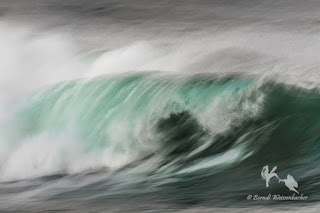
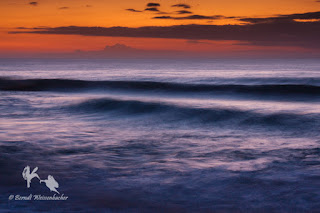

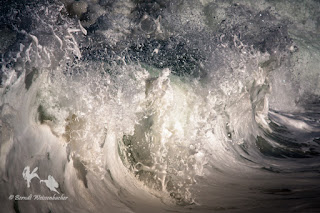
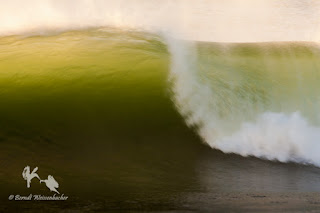
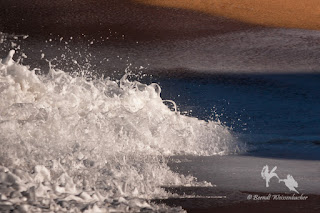

Love this series. Amazing how many colours and moods the ocean brings us. I see it everyday and it's never the same.
ReplyDeleteThank you very much, Astrid. Agreed - could happily spend the rest of my life simply watching!
Delete